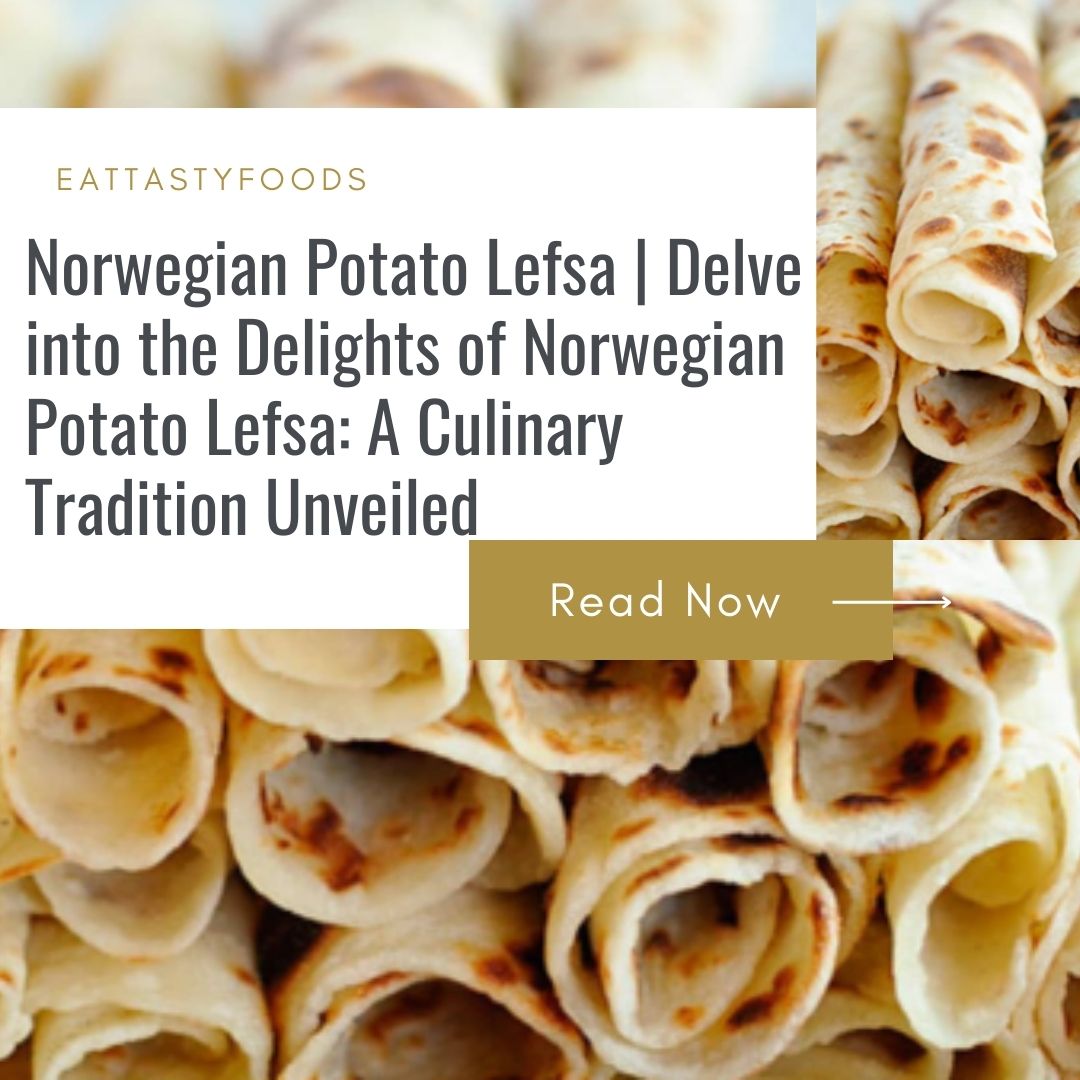Norwegian Potato Lefsa, often simply referred to as “Lefsa,” is a traditional Norwegian flatbread made primarily from potatoes. It holds a significant place in Norwegian cuisine and culture, cherished for its simplicity, versatility, and delicious taste. Let’s delve into the rich history, ingredients, preparation methods, and cultural significance of this beloved Scandinavian dish.
History of Lefsa
Lefsa traces its roots back to Norwegian and Scandinavian culinary traditions. Historically, it was a practical solution for preserving potatoes during the long winter months. The process of making lefsa was a communal activity, often undertaken by families and communities during harvest times.
Ingredients Required
The ingredients for making lefsa are straightforward and typically include mashed potatoes, flour, butter, and salt. Some variations may incorporate milk or cream for added richness.
Traditional Methods of Making Lefsa
Traditionally, lefsa is made by mixing mashed potatoes with flour to form a dough, which is then rolled out thinly and cooked on a griddle or skillet. The resulting flatbread is soft, pliable, and slightly crispy on the edges.
Variations in Lefsa
While the basic recipe for lefsa remains consistent, there are numerous regional and personal variations. Some recipes may include additional flavorings such as sugar, cinnamon, or cardamom, while others may incorporate different types of flour for a unique texture.
Health Benefits
Despite its simplicity, lefsa offers several health benefits. It is low in fat, cholesterol-free, and provides a good source of carbohydrates, making it a nutritious option when consumed in moderation.
Lefsa in Norwegian Culture
Lefsa holds a special place in Norwegian culture, often served during holidays, celebrations, and family gatherings. It symbolizes warmth, togetherness, and tradition, fostering a sense of community and connection.
Read:- Gluten-Free Irish Potato Farls: A Delicious Twist on a Traditional Recipe
Popular Lefsa Recipes
There are countless recipes for incorporating lefsa into various dishes. From savory fillings like cured meats and cheeses to sweet toppings like jam or sugar, the versatility of lefsa makes it suitable for any meal or occasion.
Lefsa Festivals
In Norway and Norwegian communities around the world, lefsa festivals are held to celebrate this beloved dish. These festivals feature live music, dancing, and of course, plenty of lefsa to enjoy.
Lefsa in Modern Cuisine
While rooted in tradition, lefsa continues to evolve in modern cuisine. Chefs and home cooks alike experiment with innovative fillings and presentations, showcasing the adaptability of this timeless dish.
Where to Find Lefsa
While traditionally homemade, lefsa can also be found in specialty stores, bakeries, and Norwegian restaurants, especially in areas with significant Scandinavian populations.
Tips for Making Perfect Lefsa
Achieving the perfect lefsa requires attention to detail. Tips for success include using high-quality ingredients, rolling the dough thinly and evenly, and cooking on a hot griddle for just the right amount of time.
Serving Suggestions
Lefsa can be served in a variety of ways, depending on personal preference and regional customs. Common serving suggestions include folding it around fillings to make wraps, serving alongside soups or stews, or simply enjoying it warm with butter.
Lefsa vs Other Potato-Based Dishes
While similar to other potato-based dishes like tortillas or flatbreads, lefsa distinguishes itself with its unique texture, flavor, and cultural significance. Its thin, soft consistency sets it apart from denser potato breads or crackers.
Here are some helpful tips to ensure success when making Norwegian Potato Lefsa:
- Use Russet Potatoes: Opt for russet potatoes for the best texture and flavor. They mash well and provide the ideal consistency for lefsa dough.
- Don’t Overcook Potatoes: Be careful not to overcook the potatoes as they can become too mushy, affecting the texture of the lefsa dough. Cook them just until they are fork-tender.
- Add Flour Gradually: When incorporating flour into the potato mixture, add it gradually. This allows you to control the dough’s consistency and avoid adding too much flour, which can result in dense lefsa.
- Keep Dough Soft and Pliable: Aim for a soft, pliable dough that is easy to roll out. If the dough is too stiff, it may be challenging to roll thinly, resulting in thicker lefsa.
- Use a Light Touch When Rolling: When rolling out the lefsa dough, use a light touch to avoid pressing too hard and making the dough too thin. Aim for an even thickness throughout.
- Use a Hot Skillet: Ensure the skillet or griddle is hot before cooking the lefsa. This helps to create the characteristic golden brown spots and ensures even cooking.
- Watch Closely While Cooking: Keep a close eye on the lefsa while cooking to prevent burning. It cooks quickly, so flip it as soon as it starts to develop golden brown spots.
- Keep Lefsa Warm: As you cook the lefsa, keep it warm by stacking cooked pieces on a plate and covering them with a clean kitchen towel. This helps retain moisture and prevents them from drying out.
- Experiment with Fillings: Get creative with your lefsa fillings! While butter and jam are classic options, try filling your lefsa with savory ingredients like cheese, cured meats, or smoked salmon for a delicious twist.
- Practice Makes Perfect: Don’t be discouraged if your first few attempts aren’t perfect. Like any skill, making lefsa takes practice. Enjoy the process and have fun experimenting with different techniques and flavors.
By following these tips, you’ll be well on your way to mastering the art of making delicious Norwegian Potato Lefsa. Enjoy the warm, comforting taste of this traditional Scandinavian flatbread with family and friends!
Norwegian Potato Lefsa offers several health benefits, making it a nutritious addition to your diet when consumed in moderation. Here are some of the health benefits of enjoying this traditional Scandinavian flatbread:
- Rich in Carbohydrates: Lefsa is primarily made from potatoes, which are a rich source of carbohydrates. Carbohydrates are the body’s main source of energy, providing fuel for everyday activities and physical exertion.
- Low in Fat: Norwegian Potato Lefsa is typically low in fat, especially if prepared with minimal added butter or oil. A low-fat diet can help reduce the risk of heart disease and maintain overall heart health.
- Cholesterol-Free: Lefsa contains no cholesterol, making it a heart-healthy option. High cholesterol levels can increase the risk of heart disease and stroke, so choosing cholesterol-free foods like lefsa can help support cardiovascular health.
- Good Source of Fiber: Depending on the recipe and ingredients used, lefsa can provide a good amount of dietary fiber. Fiber is essential for digestive health, promoting regular bowel movements and preventing constipation. It also helps maintain healthy cholesterol levels and can contribute to satiety, aiding in weight management.
- Nutrient-Rich: In addition to carbohydrates, potatoes contain essential vitamins and minerals, including vitamin C, potassium, and B vitamins. These nutrients play various roles in supporting overall health, including immune function, electrolyte balance, and energy metabolism.
- Gluten-Free Options: While traditional lefsa is made with flour, gluten-free variations can be made using alternative flours such as rice flour or almond flour. This allows individuals with gluten sensitivities or celiac disease to enjoy lefsa without adverse reactions.
- Versatile and Customizable: Lefsa can be enjoyed in various ways, making it easy to incorporate into a balanced diet. Whether served as a wrap with lean protein and vegetables or enjoyed as a snack with a spread of hummus or nut butter, lefsa offers versatility and flexibility in meal planning.
- Cultural and Emotional Benefits: Beyond its nutritional value, Norwegian Potato Lefsa holds cultural significance and is often enjoyed as part of traditional celebrations and gatherings. Sharing meals with loved ones and participating in cultural traditions can have positive effects on mental and emotional well-being.
Overall, Norwegian Potato Lefsa can be a wholesome and satisfying addition to your diet, offering a balance of carbohydrates, vitamins, and minerals. Enjoyed in moderation and as part of a varied and balanced diet, lefsa can contribute to overall health and well-being.
Conclusion
In conclusion, Norwegian Potato Lefsa is more than just a flatbread—it’s a symbol of Norwegian heritage, tradition, and culinary craftsmanship. Whether enjoyed at a festive gathering or savored as a simple snack, lefsa continues to captivate taste buds and bring people together through its timeless appeal.
FAQs
1. Is lefsa gluten-free? No, traditional lefsa contains flour, which is not gluten-free. However, gluten-free variations can be made using alternative flours.
2. Can lefsa be frozen? Yes, lefsa can be frozen for later use. Simply wrap it tightly in plastic wrap or aluminum foil and store it in the freezer.
3. How long does lefsa stay fresh? When stored properly in an airtight container or wrapped in plastic, lefsa can stay fresh for several days at room temperature or longer in the refrigerator.
4. Can lefsa be reheated? Yes, lefsa can be reheated by briefly warming it in a skillet or microwave until heated through.
5. Is lefsa only eaten in Norway? While lefsa is most closely associated with Norwegian cuisine, similar potato flatbreads are enjoyed in other Scandinavian countries and among Norwegian communities worldwide.
- What is Norwegian Potato Lefsa? Norwegian Potato Lefsa, often referred to as just “Lefsa,” is a traditional flatbread from Norway made primarily from potatoes.
- How is Norwegian Potato Lefsa pronounced? It is pronounced “LEF-suh.”
- What are the main ingredients of Norwegian Potato Lefsa? The main ingredients include potatoes, flour, butter, and salt.
- Is Norwegian Potato Lefsa gluten-free? Traditional lefsa contains flour, so it is not gluten-free. However, gluten-free variations can be made using alternative flours.
- How is Norwegian Potato Lefsa typically served? Lefsa can be served in various ways, including with butter and sugar, filled with savory ingredients like cheese and meat, or topped with jam or lingonberry sauce.
- Is Norwegian Potato Lefsa a sweet or savory dish? It can be both. Lefsa can be enjoyed as a sweet treat with sugar and butter or as a savory snack with cheese and meats.
- What is the texture of Norwegian Potato Lefsa like? Lefsa has a soft and thin texture, similar to a tortilla or crepe.
- Can Norwegian Potato Lefsa be frozen? Yes, lefsa can be frozen for later use. Wrap it tightly in plastic wrap or aluminum foil before freezing.
- How long does Norwegian Potato Lefsa stay fresh? When stored properly in an airtight container or wrapped in plastic, lefsa can stay fresh for several days at room temperature or longer in the refrigerator.
- Can Norwegian Potato Lefsa be reheated? Yes, lefsa can be reheated by briefly warming it in a skillet or microwave until heated through.
- What is the history of Norwegian Potato Lefsa? Lefsa originated as a way to preserve potatoes during the winter months in Norway. It has been a staple in Norwegian cuisine for centuries.
- Are there any health benefits to eating Norwegian Potato Lefsa? Yes, lefsa is low in fat, cholesterol-free, and provides a good source of carbohydrates. It can also be made with gluten-free flours for those with sensitivities.
- What are some popular fillings for Norwegian Potato Lefsa? Popular fillings include butter and sugar, cinnamon, jam, cheese, cured meats, and smoked salmon.
- Are there any traditional festivals or celebrations associated with Norwegian Potato Lefsa? Yes, lefsa festivals are held in Norway and Norwegian communities around the world to celebrate this beloved dish.
- Can Norwegian Potato Lefsa be made ahead of time? Yes, lefsa can be made ahead of time and stored in an airtight container or frozen for later use.
- Can Norwegian Potato Lefsa be made without butter? Yes, lefsa can be made without butter, but it may affect the flavor and texture slightly.
- What is the traditional method of cooking Norwegian Potato Lefsa? Traditionally, lefsa is cooked on a hot griddle or skillet until golden brown spots appear on both sides.
- Can Norwegian Potato Lefsa be made with sweet potatoes? While traditionally made with white potatoes, sweet potatoes can be used as a variation for a different flavor profile.
- Is Norwegian Potato Lefsa a breakfast food? It can be enjoyed for breakfast, lunch, or as a snack, depending on personal preference.
- What is the significance of Norwegian Potato Lefsa in Norwegian culture? Lefsa holds cultural significance in Norway and is often associated with holidays, celebrations, and family gatherings.
- Can Norwegian Potato Lefsa be made vegan? Yes, lefsa can be made vegan by using plant-based butter or omitting the butter altogether.
- Are there any special tools needed to make Norwegian Potato Lefsa? While not required, a griddle or skillet and a rolling pin are helpful for cooking and rolling out the lefsa dough.
- Can Norwegian Potato Lefsa be made with whole wheat flour? Yes, whole wheat flour can be used as a healthier alternative to white flour in lefsa recipes.
- What are some creative ways to serve Norwegian Potato Lefsa? Lefsa can be used as a wrap for sandwiches, filled with scrambled eggs and vegetables for breakfast burritos, or served with soup or stew.
- Is Norwegian Potato Lefsa only eaten in Norway? While lefsa is most closely associated with Norwegian cuisine, similar potato flatbreads are enjoyed in other Scandinavian countries and among Norwegian communities worldwide.
These questions and answers provide insights into the delicious and versatile world of Norwegian Potato Lefsa, offering a glimpse into its history, preparation methods, and cultural significance.










